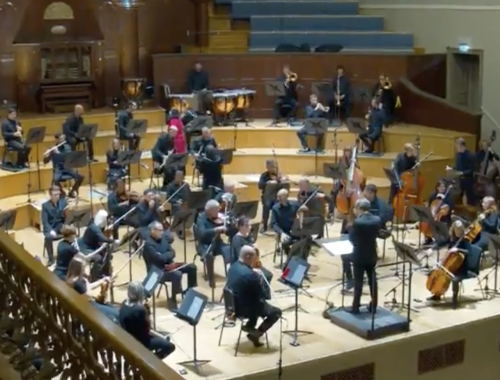Reflexes like a ninja… or so I’d like to think!
Ah, the joys of live video shoots, having to think fast and reflect later about what went wrong – not stressful at all!
The concept of live streaming is not new to me having completed a live television programme, but that doesn’t mean I am a seasoned veteran just yet (although I’m getting there). However, in the television programme I took on the role of Producer, whereas in the SARC Video Team I opted to expand my camera skills by choosing a more technical role.

Using Gibbs Reflective Cycle (1), I will reflect upon my experience live streaming in this blog, exploring how the initial shoot helped me to create a systematic approach for future shoots.
Each week my job was to capture musicians playing their instruments to stream it online, whilst having a voice in my ear telling what to do. This of course was through comms, I didn’t go mad I promise! Having to react to changes in real time, while not disrupting the shoot created a unique challenge for me. Every musician liked to do the bows differently, which at first was daunting. Especially the first performance.
During this performance the musicians bowed on stage and walked off down the centre aisle. As we were positioned in the wings we could not see the back of the room and wrongly assumed they had left. Then suddenly we get a loud voice saying “Zoom out camera 1!” as the pair made their way back up the aisle for a second bow. However camera 1 comms had stopped working and they didn’t hear this or understand the signals we were trying to give. This was very panic-inducing as I knew our safety shot would be used which was currently on an empty stage. I had to react quickly, by using the STOP skill (2) I realised I could hurriedly reframe my camera for a nice shot, which the vision mixer noticed as I saw my camera go live.

Using this skill preventing me from being overly anxious given the high-pressure atmosphere of live-streaming, as once I felt myself panicking I stopped what I was doing, took a deep breath and a literal step back to gain a larger perspective of the room. Then I looked around the room to gage what shots are available from the angle and position of my camera. Finally I moved and reframed as quickly as possible to ensure I am providing the best shot possible for the vision mixer to choose from.
Reacting to unplanned changes created an interesting experience as my camera experience before was limited to interviews which I could edit after shooting and b-roll which I could re-take multiple times to get the perfect shot. A positive of the experience is that I didn’t overthink the shot and was able to react quickly by using my initiative and creative vision. In this instance, using my initiative was a good thing but I can’t rely on this as the moving camera when reframing limits the shots available for the vision mixer, therefore should be used as a last resort only.
However, this experience did create a lack of content in the stream for a brief moment, which would have taken away from the viewing experience.
“Viewers prioritize lifelikeness in live streams. They want virtual events to mirror in-person events.”
GWI Coronavirus Research March 2020 (3)
Therefore although only a few seconds, the online audience would have been left confused. However I feel as though I reacted accordingly as there wasn’t much else we could have done as we did try to signal camera 1. We were quite short staffed this day and it would have been helpful to have a floor manager as well as a producer, vision mixer, sound and camera operators, as they could have informed the relevant operator of the issue with haste by telling them in person. Going forward, the Video team discussed an action plan to ensure if unforeseen circumstances occur we would be ready. To ensure comms was operational we constantly checked in with each other until we had to go live. We created a WhatsApp group chat to use to communicate if comms went down as a backup, as well as creating hand signals as an additional failsafe method in case something went wrong. We decided to only reposition our camera if communicate wasn’t possible as it could throw off the vision mixer or do disrupt the feed by moving the camera.

This plan helped with future live-streams as despite the unpredictable nature of the moving musicians, the technical side of things was cyclical in terms of repeated shots and usage. By having been “thrown in the deep end” for live-streaming I was able to learn skills in real time that would be specific to the placement and ensure I was prepared for future shoots. Furthermore this on-the-job type of work-based learning ensured improvement within my technical camera skills – which was my goal from the very beginning. (4). By undertaking these work-based activities I was learning a new transferable skill that I got more confident with the more I filmed, allowing my reaction time to become quicker leading to even speedier reflexes!
References
- Gibbs, Graham. “Learning by doing: A guide to teaching and learning methods.” Further Education Unit (1988).
- Vaughn, Stephanie. DBT Distress Tolerance Skills: Tip Skill, Stop Skill, and More. Psychotherapy Academy, 5 Oct, 2021, https://psychotherapyacademy.org/dbt/distress-tolerance-skills/. Accessed 27 November 2021.
- Krings, Emily. 114 Live Streaming Statistics Every Broadcaster Should Know [2021 Update]. Dacast, August 20, 2021, https://www.dacast.com/blog/66-must-know-live-streaming-statistics/. Accessed 27 November 2021.
- Cunningham, Ian, and Graham Dawes. The handbook of work based learning. Routledge, 2016.
Bibliography
- Athuraliya, Amanda. “How to Write an Action Plan: Step-by-Step Guide with Templates.” Creately Blog, Creately, 15 Sept. 2021, https://creately.com/blog/diagrams/how-to-write-an-action-plan/.
- Cunningham, Ian, and Graham Dawes. The handbook of work based learning. Routledge, 2016.
- Gibbs, Graham. “Learning by doing: A guide to teaching and learning methods.” Further Education Unit (1988).
- Krings, Emily. 114 Live Streaming Statistics Every Broadcaster Should Know [2021 Update]. Dacast, August 20, 2021, https://www.dacast.com/blog/66-must-know-live-streaming-statistics/. Accessed 27 November 2021.
- Vaughn, Stephanie. DBT Distress Tolerance Skills: Tip Skill, Stop Skill, and More. Psychotherapy Academy, 5 Oct, 2021, https://psychotherapyacademy.org/dbt/distress-tolerance-skills/. Accessed 27 November 2021.
You May Also Like

In at the Deep End: Recording an Orchestra
26 November 2021
AAAH or (Why Tom sucks at selling himself)
25 November 2021
